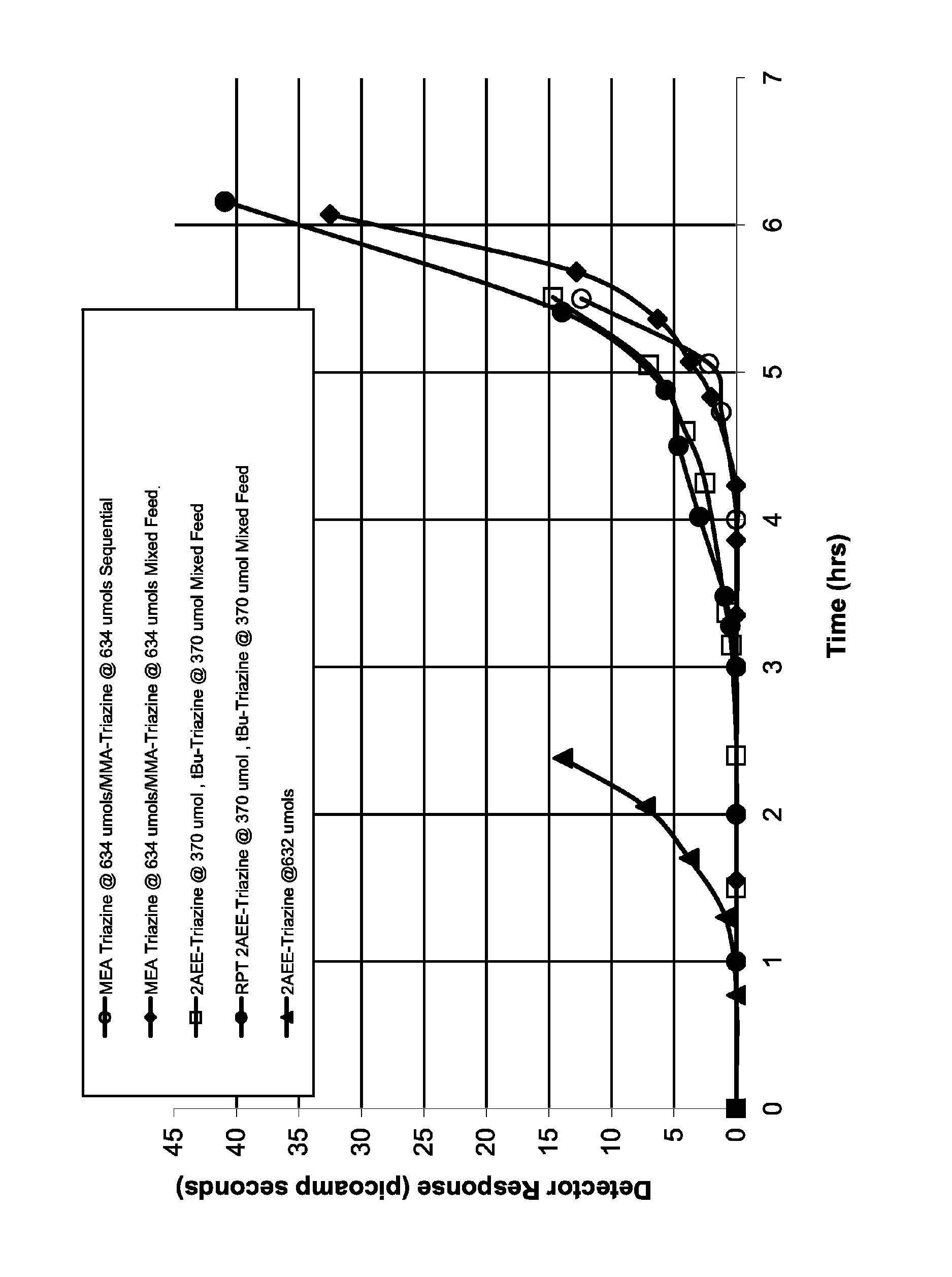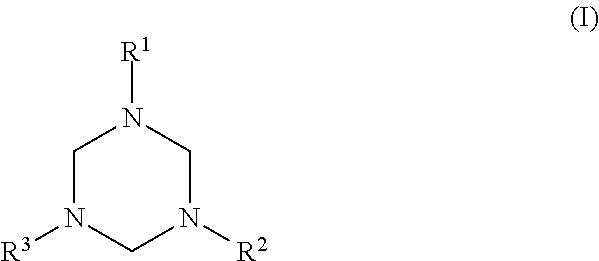Method of scavenging hydrogen sulfide and/or mercaptans using triazines
a technology which is applied in the direction of hydrogen sulfides, separation processes, sulfur compounds, etc., can solve the problems of severe health hazards, objectionable presence high corrosion of hydrogen sulfide and mercaptans,
- Summary
- Abstract
- Description
- Claims
- Application Information
AI Technical Summary
Problems solved by technology
Method used
Image
Examples
example 1
Synthesis of 1,3,5-tris(N-(2-hydroxyethyl)-2-aminoethyl)hexahydro-s-triazine (2AEE-TRZ)
[0035]Water and formaldehyde (18.5 g, 0.62 moles) were added to a reaction flask. The flask was then cooled with an ice bath. 2-Aminoethylethanolamine (67.34 g, 0.64 moles) was added dropwise and a strong exothermic reaction was observed. The temperature was controlled to not exceed 50 C. After complete addition, the reaction mixture was stirred for a further 3 hours to ensure complete reaction. (This reaction could be carried out with either 37% aqueous formalin or paraformaldehyde as the source of formaldehyde.) The resulting product had the structural formula:
[0036]
example 2
Synthesis of mixed 2-aminoethylethanolamine and t-butylamine hexahydrotriazine (2AEE / tBu-TRz)
[0037]Water and formaldehyde (18.5 g, 0.62 moles) were added to a reaction flask which was then cooled with an ice bath. This material can be synthesized in three ways. The desired product was then synthesized by three different procedures:
[0038](a) the addition of 2-aminoethylethanolamine (33.6 g, 0.323 moles) and t-butylamine (23.6 g, 0.323 moles);
[0039](b) the sequential addition of 2-aminoethylethanolamine (33.6 g, 0.323 moles) followed by the addition of t-butylamine (23.6 g, 0.323 moles); and
[0040](c) the sequential addition of t-butylamine (23.6 g, 0.323 moles) followed by the addition of 2-aminoethylethanolamine (33.6 g, 0.323 moles).
[0041]In procedure (b) and (c), a mild exotherm was observed during the addition of the t-butylamine and a much stronger exotherm was observed during the addition of 2-aminoethylethanolamine. By following (a), (b) and (c), a totally homogenous solution o...
example 3
[0043]The compound of formula (IV) was prepared by slowly adding 2.1 moles (154.6 g)) of t-butyl amine into 2.0 moles of formaldehyde as 165.3 g of 37% formalin solution with continuous stirring. The preparation was carried out in a round bottom reaction flask equipped with an additional funnel, a magnetic stirrer, and a cooling bath. The t-butyl amine was added at such a rate that the temperature did not exceed 42° C. The reaction mixture was allowed to cool and was transferred to a reparatory funnel. The lower aqueous phase was drained off and the top organic phase was separated and dried with anhydrous reagent magnesium sulfate and the product collected by filtration. This material was then dried a second time with anhydrous magnesium sulfate. NMR analysis confirmed the product to that of formula (IV). See, U.S. Pat. No. 5,674,377, herein incorporated by reference.
[0044]The product of formula (IV) was then mixed in a beaker at equal molar proportions with the compound of formula ...
PUM
| Property | Measurement | Unit |
|---|---|---|
| temperatures | aaaaa | aaaaa |
| temperatures | aaaaa | aaaaa |
| temperature | aaaaa | aaaaa |
Abstract
Description
Claims
Application Information
 Login to View More
Login to View More - R&D
- Intellectual Property
- Life Sciences
- Materials
- Tech Scout
- Unparalleled Data Quality
- Higher Quality Content
- 60% Fewer Hallucinations
Browse by: Latest US Patents, China's latest patents, Technical Efficacy Thesaurus, Application Domain, Technology Topic, Popular Technical Reports.
© 2025 PatSnap. All rights reserved.Legal|Privacy policy|Modern Slavery Act Transparency Statement|Sitemap|About US| Contact US: help@patsnap.com



